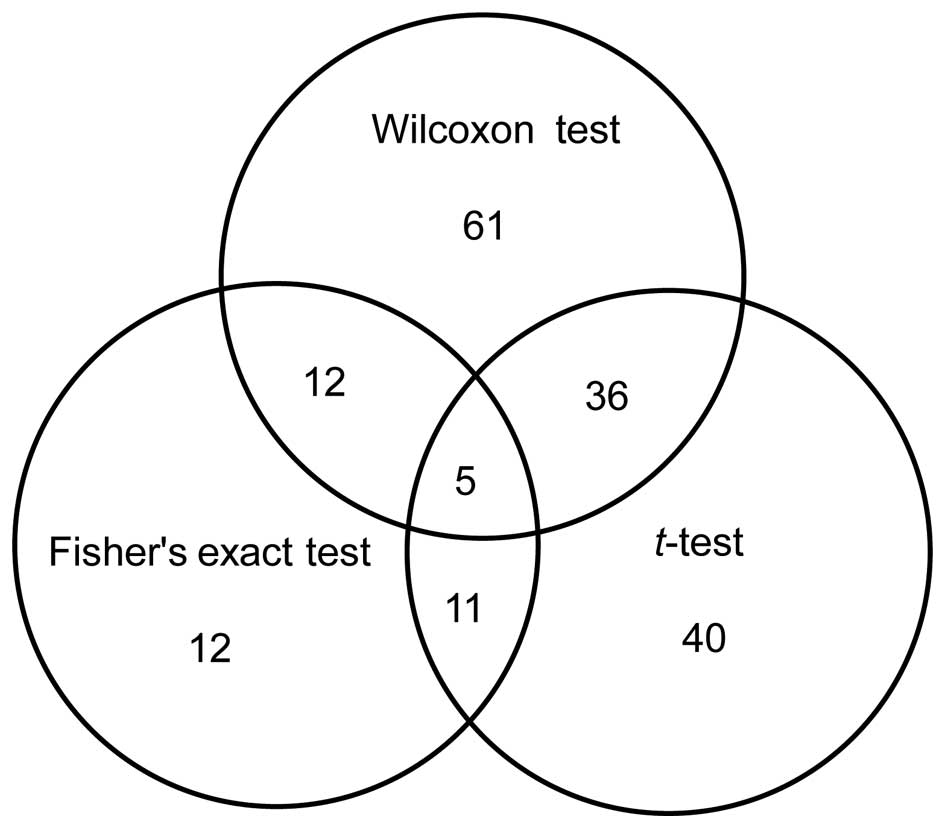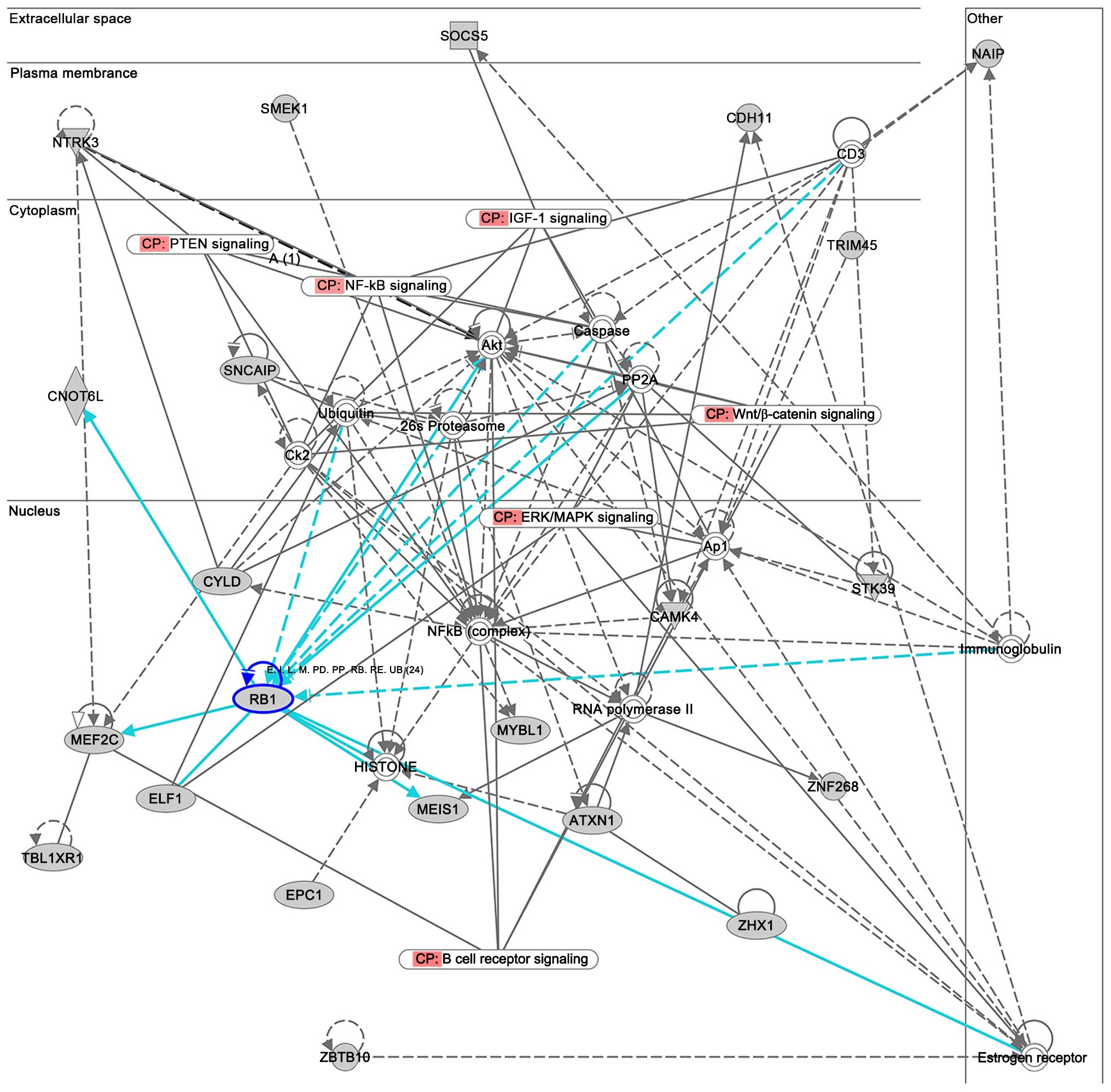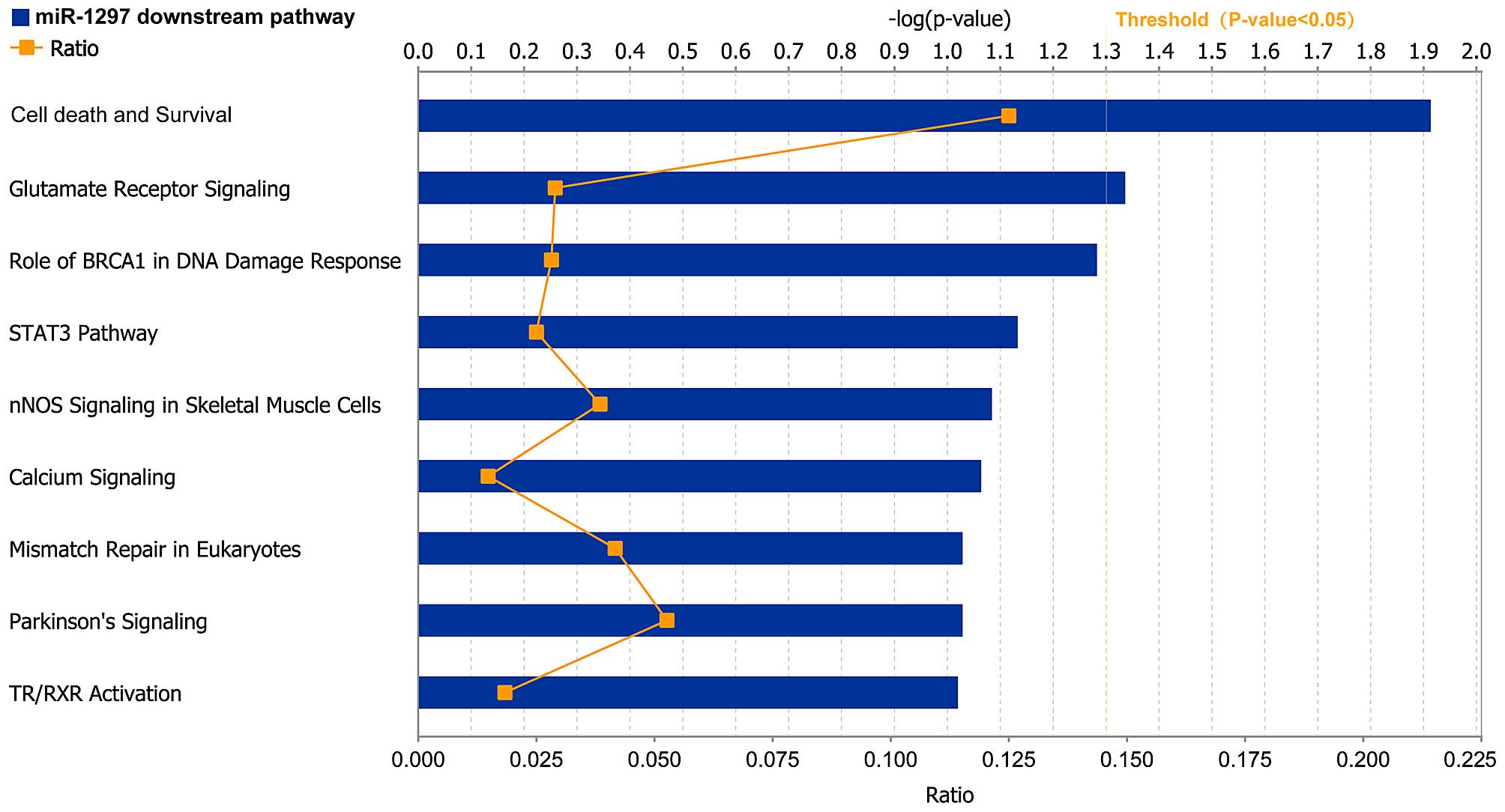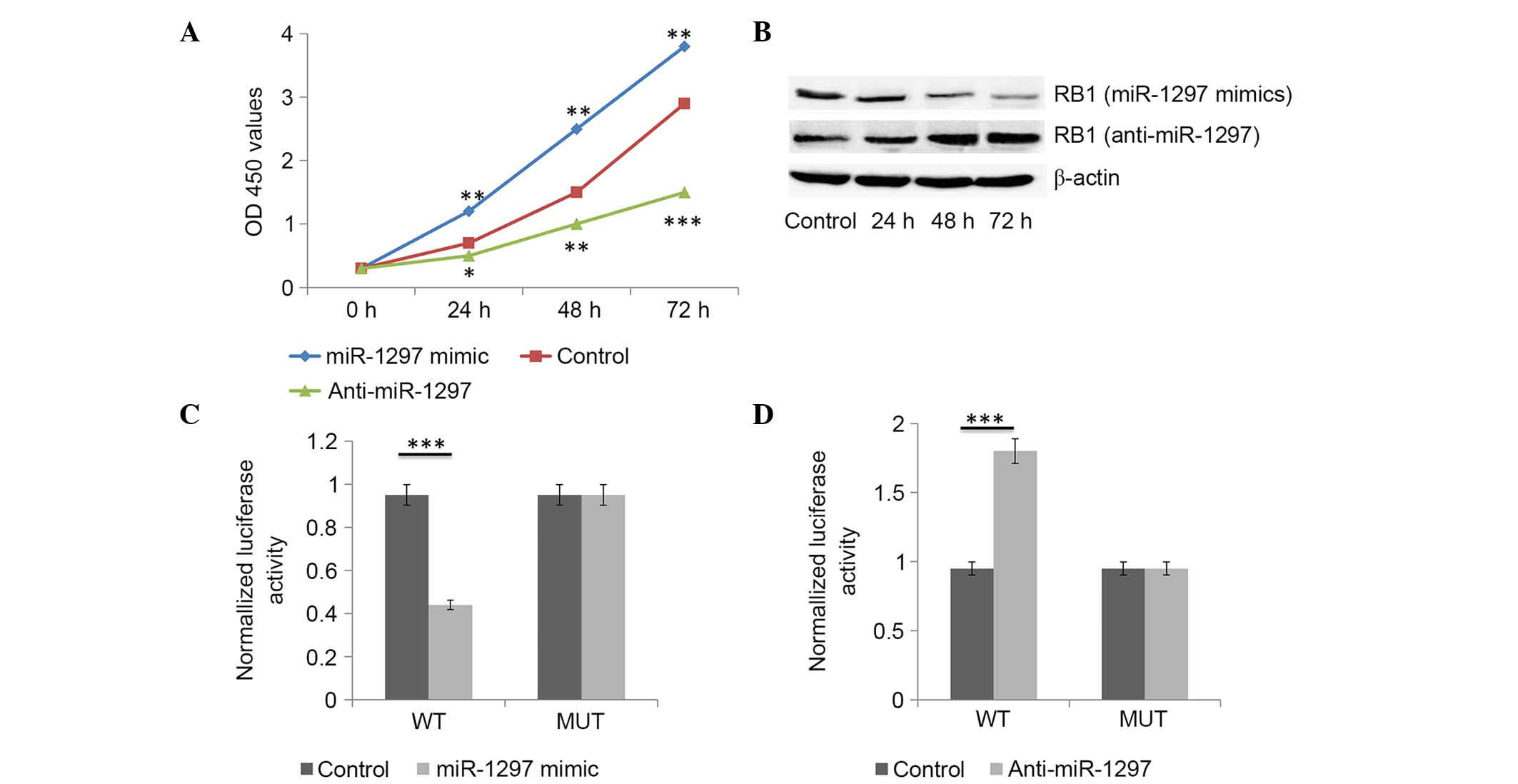miR-1297 promotes cell proliferation by inhibiting RB1 in liver cancer
- Authors:
- Published online on: October 31, 2016 https://doi.org/10.3892/ol.2016.5326
- Pages: 5177-5182
Abstract
Introduction
Liver cancer is one of the most common causes of cancer-associated mortality worldwide (1). Its five-year survival rate is significantly lower than that of other types of cancer (2), mainly because the majority of liver cancer patients are at late stage when they are diagnosed (3). Therefore, it is necessary to identify new biomarkers for early diagnosis of liver cancer (4).
MicroRNAs (miRNAs or miRs) are short non-coding RNAs with an average length of 20–25 nt (5). By binding to the 3′ untranslated region (UTR) of their target messenger (m)RNA molecules, miRNAs inhibit the translation of their target mRNA molecules (6). However, in limited cases, the binding sites are located in the 5′ UTR or in the coding region of the target mRNA (6). miRNAs are important in regulating various biological processes, including cell development, cell proliferation, cell differentiation and cell apoptosis. Several previous studies have reported that miRNAs participate in the initiation and carcinogenesis of cancer (7,8). The carcinogenesis of liver cancer and its associated miRNAs have become a research hotspot area (9). The results of previous studies have revealed that miRNAs could be candidate prognostic and diagnostic biomarkers for liver cancer (9).
The present study, with miRNA expression microarray data obtained from the Gene Expression Omnibus (GEO) database, aimed to identify the key miRNAs involved in the carcinogenesis of liver cancer. In order to obtain confident results, differentially expressed miRNAs in liver cancer were identified by combining the results of three independent methods: Fisher's exact test, t-test and Wilcoxon test. Target genes of the selected miRNAs were predicted also by three independent methods: DIANA (10), miRanda (11) and TargetScan (12). Ingenuity Pathway Analysis (IPA) was conducted using the targets of the identified miRNAs to explore the underlying mechanisms of carcinogenesis of liver cancer.
Materials and methods
Microarray data of miRNA
From the GEO database (https://www.ncbi.nlm.nih.gov/geo/), the microarray data of miRNA GSE6857 and GSE30297, which represent miRNA expression profile data from 496 liver cancer patients and 35 normal controls, respectively, were obtained. The data sets were based on the platforms GPL4700 and GPL8786, respectively. All raw data, including the original CEL, GPR and SOFT files, were obtained for further analysis.
Detection of differentially expressed miRNAs in liver cancer
Normalization of the raw miRNA data was performed in R platform (version 3.1.3; https://www.r-project.org/) using the Robust Multi-array Analysis (RMA) method (13). The final log2-transformed RMA expression values were then stored for further analysis. Three independent tests, including Fisher's exact test, t-test and Wilcoxon test, were used to identify significantly differentially expressed miRNAs between liver cancer and normal control samples. The miRNAs that were supported by the above three tests were considered to be confidently involved in the carcinogenesis of liver cancer.
Prediction of miRNAs target genes
Prediction of target genes for the differentially expressed miRNAs was performed using current available methods, including DIANA (10), miRanda (11) and TargetScan (12). In order to reduce the false-positive rate of target prediction, the predicted targets supported by at least two independent methods were selected as reliable target genes of miRNAs. In addition, miRNAs target genes with wet experimental support in the TarBase 6.0 database (14) were also included in the final pathway analysis.
IPA
The most significantly differentially expressed miRNAs identified in the previous steps were selected for IPA. The Ingenuity Knowledge database (http://www.ingenuity.com/products/ipa) and IPA tools were used to identify the enriched roles of miRNAs and their target genes in cellular functions, pathways and diseases.
Cell culture and transfection
The human liver cancer cell line HepG2 was obtained from the Chinese Center for Type Culture Collection (Beijing, China). The HepG2 cell line was first cultured in RPMI-1640 medium (Thermo Fisher Scientific, Inc., Waltham, MA, USA) supplemented with 10% fetal bovine serum (Thermo Fisher Scientific, Inc.). Cells were maintained in a humidified atmosphere with 5% CO2 at 37°C. HepG2 cells were seeded in 24-well plates at 6×105 cells/well and incubated overnight. Transfection of the miR-1297 mimics, anti-miR-1297, inactive control cel-mir-67 or pMIR-REPORT vector (all Thermo Fisher Scientific, Inc.) was performed using Lipofectamine 2000 transfection reagent (Invitrogen; Thermo Fisher Scientific, Inc.) with 300 nmol miRNA or 1 µg/ml DNA plasmid, respectively. Total proteins of HepG2 cells were isolated at 48 h post-transfection using M-PER Reagent (Thermo Fisher Scientific, Inc.).
Western blotting
Proteins were separated by 12% SDS-PAGE and then transferred onto nitrocellulose membranes (Bio-Rad Laboratories, Inc., Hercules, CA, USA). Membranes were blocked with 5% non-fat milk and incubated with anti-retinoblastoma (RB)1 antibody (cat. no. ab181616; Abcam, Shanghai, China) or anti-β-actin antibody (cat. no. ab8227; Abcam) at 4°C overnight. Following extensive washes with TBST, a secondary antibody (cat. no. ab150077; Abcam) was added to the system. Finally, enhanced chemiluminescence (Abcam) was used to detect the immunoreactive protein bands.
Cell proliferation assay
Cell proliferation assay was performed with Cell Counting Kit-8 (CCK-8; Dojindo Molecular Technologies, Inc., Kumamoto, Japan). HepG2 liver cancer cells were plated at 6×105 cells/well in 24-well plates. Then, cells were incubated in 10% CCK-8 at 37°C for color conversion. Proliferation rates were detected at 24, 48 and 72 h post-transfection.
Luciferase assay
HepG2 cells were seeded at 6×105 cells/well in 24-well plates and incubated for 24 h. Subsequently, the cells were co-transfected with 0.8 µg pGL3-RB1-3′UTR or pGL3-RB1-3′UTR Mut plasmid or with 0.08 ng phRL-SV40 control vector (all Promega Corporation, Madison, WI, USA), and with 100 nM miR-1297 or inactive control RNA, using Lipofectamine 2000 (Invitrogen; Thermo Fisher Scientific, Inc.). The Renilla luciferase and firefly luciferase activities were detected using a dual luciferase assay (Promega Corporation) at 24 h post-transfection.
Statistical analysis
Statistical analyses were performed using R (version 3.1.3; https://www.r-project.org/). Values were expressed as means ± standard deviation. Differences between groups were estimated with the Student's t-test. P<0.05 was considered to indicate a statistically significant difference.
Results
Differentially expressed miRNAs in liver cancer
Based on the combined results of the three independent tests, five miRNAs were identified to be significantly differentially expressed in liver cancer (Fig. 1 and Table I), including three upregulated and two downregulated miRNAs. Among these miRNAs, miR-1297 had the most significant deregulation.
Target genes prediction
Since miRNAs serve their functions by targeting mRNAs, the predicted target genes of the differentially expressed miRNAs were retrieved. The most significant deregulated miRNA, miR-1297, attracted our attention because one of its target genes supported by multiple evidences is the tumor-suppressor gene RB1 (Fig. 2), which is involved in the regulation of the cell cycle and in human cancer pathways (hsa04110 and hsa05200 Kyoto Encyclopedia of Genes and Genomes pathways) (15–17).
IPA
The predicted target genes of miR-1297 were collected and imported into the IPA system to investigate their biological functions in liver cancer. Table II contains the top five most significant networks identified by IPA. Among these networks, cell death and survival was the most frequent function, with a significant score of 43 (Table II). IPA also indicated that miR-1297 target genes were involved in various biological functions, including cell cycle and cellular development (Table III). Cell death and survival as well as glutamate receptor signaling were the most significant pathways enriched in target genes of miR-1297 (Fig. 3).
miR-1297 promotes liver cancer cell proliferation
The potential impact of miR-1297 on liver cancer cell proliferation was assessed in the HepG2 cell line. HepG2 cells were transfected with miR-1297 mimics or miR-1297 inhibitor, or with the inactive control cel-mir-67. CCK-8 proliferation assay indicated that cell proliferation was significantly promoted in miR-1297-mimics-transfected HepG2 cells compared with that in inactive control cel-mir-67-transfected cells (Fig. 4A). Conversely, miR-1297 inhibitor significantly inhibited the proliferation of HepG2 cells (Fig. 4A).
miR-1297 targets and negatively regulates RB1 in liver cancer cells
miR-1297 mimics significantly reduced the protein levels of RB1 in liver cancer cells (Fig. 4B). Conversely, miR-1297 inhibitor significantly increased the protein levels of RB1 in liver cancer cells (Fig. 4B). As predicted by bioinformatics analysis, there was complementarity between hsa-miR-1297 and the 3′UTR of RB1. The effect of miR-1297 on the translation of RB1 mRNA into protein was then determined using a luciferase reporter assay. miR-1297 mimics significantly reduced the luciferase activity of the reporter gene with the wild-type construct but not with the mutant RB1 3′UTR construct (Fig. 4C). The inhibitor of miR-1297 significantly enhanced the luciferase activity of the reporter gene with the wild-type construct but not with the mutant RB1 3′UTR construct (Fig. 4D). These evidences indicate that miR-1297 directly binds to the 3′UTR region of RB1. In general, miR-1297 targets and negatively regulates RB1 in liver cancer cells.
Discussion
In the present study, using three independent tests (Fisher's exact test, t-test and Wilcoxon test), five differentially expressed miRNAs were identified, which may play crucial roles in the carcinogenesis of liver cancer (Table I). Upon retrieving and analyzing the target genes of these five miRNAs, the most significantly deregulated miRNA, miR-1297, attracted our attention. One of its target genes with various supporting evidences is the tumor-suppressor gene RB1. The RB1 gene encodes a negative regulator of the cell cycle, and was known to be a tumor suppressor of multiple types of cancer (15–17), including liver cancer (18). In addition, RB1 is involved in the human cancer pathway (http://www.kegg.jp/kegg/pathway.html, hsa04110 and hsa05200). This leads to the hypothesis that miR-1297 may be important in liver cancer.
Therefore, IPA was conducted to analyze the biological function of the target genes of miR-1297. IPA is based on the Ingenuity Knowledge Base, which derives known biological functions and interactions of genes from published studies. IPA allows the identification of biological networks, functions and pathways that are associated with the target genes of miR-1297. The results indicated that cell death and survival was the highest-rated miR-1297 downstream biological network, with a significance score of 43. The cell cycle was the most enriched cellular function of miR-1297 target genes, as shown in Table II. These results revealed that miR-1297 may participate in cancer through regulating cell death or the cell cycle. Generally, miR-1297 may be important in the carcinogenesis of liver cancer through regulation of its target genes, particularly the tumor-suppressor gene RB1. To date, no other studies have reported an association between miR-1297 and liver cancer. However, miR-1297 has been reported to regulate the carcinogenesis of colorectal cancer (19), lung adenocarcinoma (20) and laryngeal squamous cell carcinoma (21). In addition, its predicted target gene, RB1, is a negative regulator of the cell cycle and a tumor-suppressor gene (22). Therefore, the roles of miR-1297 in liver cancer were validated by wet experiments.
CCK-8 proliferation assay indicated that cell proliferation was promoted by miR-1297 in the HepG2 cell line, while miR-1297 inhibitor could significantly inhibit the proliferation of this cell line. Western blotting revealed that miR-1297 suppressed the expression of RB1 at the protein level in HepG2 cells. Furthermore, luciferase assays confirmed that miR-1297 directly bound to the 3′UTR of RB1 and suppressed its expression. In conclusion, these results indicated that miR-1297 promotes cell proliferation in liver cancer by negatively regulating the cell cycle-inhibitory gene RB1. Therefore, miR-1297 may be a potential therapeutic target for liver cancer in the future.
References
|
Ghouri YA, Mian I and Blechacz B: Cancer review: Cholangiocarcinoma. J Carcinog. 14:12015. View Article : Google Scholar : PubMed/NCBI | |
|
Tejeda-Maldonado J, Garcia-Juarez I, Aguirre-Valadez J, González-Aguirre A, Vilatobá-Chapa M, Armengol-Alonso A, Escobar-Penagos F, Torre A, Sánchez-Ávila JF and Carrillo-Pérez DL: Diagnosis and treatment of hepatocellular carcinoma: An update. World J Hepatol. 7:362–376. 2015. View Article : Google Scholar : PubMed/NCBI | |
|
Kinoshita A, Onoda H, Fushiya N, Koike K, Nishino H and Tajiri H: Staging systems for hepatocellular carcinoma: Current status and future perspectives. World J Hepatol. 7:406–424. 2015. View Article : Google Scholar : PubMed/NCBI | |
|
Kimhofer T, Fye H, Taylor-Robinson S, Thursz M and Holmes E: Proteomic and metabonomic biomarkers for hepatocellular carcinoma: A comprehensive review. Br J Cancer. 112:1141–1156. 2015. View Article : Google Scholar : PubMed/NCBI | |
|
Lee RC, Feinbaum RL and Ambros V: The C. elegans heterochronic gene lin-4 encodes small RNAs with antisense complementarity to lin-14. Cell. 75:843–854. 1993. View Article : Google Scholar : PubMed/NCBI | |
|
Malumbres M and Barbacid M: RAS oncogenes: The first 30 years. Nat Rev Cancer. 3:459–465. 2003. View Article : Google Scholar : PubMed/NCBI | |
|
Garzon R, Calin GA and Croce CM: MicroRNAs in cancer. Annu Rev Med. 60:167–179. 2009. View Article : Google Scholar : PubMed/NCBI | |
|
Nicolaidou V and Koufaris C: MicroRNA responses to environmental liver carcinogens: Biological and clinical significance. Clin Chim Acta. 445:25–33. 2015. View Article : Google Scholar : PubMed/NCBI | |
|
Hung CH, Chiu YC, Chen CH and Hu TH: MicroRNAs in hepatocellular carcinoma: Carcinogenesis, progression and therapeutic target. Biomed Res Int. 2014:4864072014. View Article : Google Scholar : PubMed/NCBI | |
|
Paraskevopoulou MD, Georgakilas G, Kostoulas N, Reczko M, Maragkakis M, Dalamagas TM and Hatzigeorgiou AG: DIANA-LncBase: Experimentally verified and computationally predicted microRNA targets on long non-coding RNAs. Nucleic Acids Res. 41:D239–D245. 2013. View Article : Google Scholar : PubMed/NCBI | |
|
John B, Enright AJ, Aravin A, Tuschl T, Sander C and Marks DS: Human MicroRNA targets. PLoS Biol. 2:e3632004. View Article : Google Scholar : PubMed/NCBI | |
|
Lewis BP, Burge CB and Bartel DP: Conserved seed pairing, often flanked by adenosines, indicates that thousands of human genes are microRNA targets. Cell. 120:15–20. 2005. View Article : Google Scholar : PubMed/NCBI | |
|
Irizarry RA, Hobbs B, Collin F, Beazer-Barclay YD, Antonellis KJ, Scherf U and Speed TP: Exploration, normalization and summaries of high density oligonucleotide array probe level data. Biostatistics. 4:249–264. 2003. View Article : Google Scholar : PubMed/NCBI | |
|
Vergoulis T, Vlachos IS, Alexiou P, Georgakilas G, Maragkakis M, Reczko M, Gerangelos S, Koziris N, Dalamagas T and Hatzigeorgiou AG: TarBase 6.0: Capturing the exponential growth of miRNA targets with experimental support. Nucleic Acids Res. 40:D222–D229. 2012. View Article : Google Scholar : PubMed/NCBI | |
|
Gordon CA, Gulzar ZG and Brooks JD: NUSAP1 expression is upregulated by loss of RB1 in prostate cancer cells. Prostate. 75:517–526. 2015. View Article : Google Scholar : PubMed/NCBI | |
|
Sabir M, Baig RM, Ali K, Mahjabeen I, Saeed M and Kayani MA: Retinoblastoma (RB1) pocket domain mutations and promoter hyper-methylation in head and neck cancer. Cell Oncol (Dordr). 37:203–213. 2014. View Article : Google Scholar : PubMed/NCBI | |
|
Kansara M and Thomas DM: RB1-mediated cell-autonomous and host-dependent oncosuppressor mechanisms in radiation-induced osteosarcoma. Oncoimmunology. 3:e275692014. View Article : Google Scholar : PubMed/NCBI | |
|
Anwar SL, Krech T, Hasemeier B, Schipper E, Schweitzer N, Vogel A, Kreipe H and Lehmann U: Deregulation of RB1 expression by loss of imprinting in human hepatocellular carcinoma. J Pathol. 233:392–401. 2014. View Article : Google Scholar : PubMed/NCBI | |
|
Chen P, Wang BL, Pan BS and Guo W: MiR-1297 regulates the growth, migration and invasion of colorectal cancer cells by targeting cyclo-oxygenase-2. Asian Pac J Cancer Prev. 15:9185–9190. 2014. View Article : Google Scholar : PubMed/NCBI | |
|
Zhang C, Chi YL, Wang PY, Wang YQ, Zhang YX, Deng J, Lv CJ and Xie SY: miR-511 and miR-1297 inhibit human lung adenocarcinoma cell proliferation by targeting oncogene TRIB2. PloS one. 7:e460902012. View Article : Google Scholar : PubMed/NCBI | |
|
Li X, Wang HL, Peng X, Zhou HF and Wang X: miR-1297 mediates PTEN expression and contributes to cell progression in LSCC. Biochem Biophys Res Commun. 427:254–260. 2012. View Article : Google Scholar : PubMed/NCBI | |
|
Di Fiore R, D'Anneo A, Tesoriere G and Vento R: RB1 in cancer: Different mechanisms of RB1 inactivation and alterations of pRb pathway in tumorigenesis. J Cell Physiol. 228:1676–1687. 2013. View Article : Google Scholar : PubMed/NCBI |













